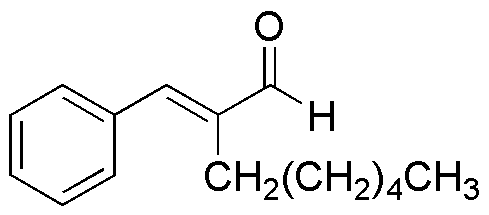a-Hexylcinnamaldehyde is widely utilized in research focused on
- Fragrance Industry: This compound is a popular ingredient in perfumes and scented products due to its pleasant floral and fruity aroma, enhancing the overall fragrance profile.
- Flavoring Agent: It is used in the food industry as a flavoring agent, providing a sweet and fruity taste that can enhance various food products.
- Cosmetics: The compound is incorporated into cosmetic formulations, such as lotions and creams, where it acts as a fragrance component, improving user experience.
- Research Applications: In scientific studies, a-Hexylcinnamaldehyde serves as a model compound for investigating the behavior of aldehydes in chemical reactions, aiding in the development of new synthetic methods.
- Insect Repellents: It has been explored for use in natural insect repellents, offering a safer alternative to synthetic chemicals while providing effective protection against pests.
General Information
Properties
Safety and Regulations
Applications
a-Hexylcinnamaldehyde is widely utilized in research focused on
- Fragrance Industry: This compound is a popular ingredient in perfumes and scented products due to its pleasant floral and fruity aroma, enhancing the overall fragrance profile.
- Flavoring Agent: It is used in the food industry as a flavoring agent, providing a sweet and fruity taste that can enhance various food products.
- Cosmetics: The compound is incorporated into cosmetic formulations, such as lotions and creams, where it acts as a fragrance component, improving user experience.
- Research Applications: In scientific studies, a-Hexylcinnamaldehyde serves as a model compound for investigating the behavior of aldehydes in chemical reactions, aiding in the development of new synthetic methods.
- Insect Repellents: It has been explored for use in natural insect repellents, offering a safer alternative to synthetic chemicals while providing effective protection against pests.
Documents
Safety Data Sheets (SDS)
The SDS provides comprehensive safety information on handling, storage, and disposal of the product.
Product Specification (PS)
The PS provides a comprehensive breakdown of the product’s properties, including chemical composition, physical state, purity, and storage requirements. It also details acceptable quality ranges and the product's intended applications.
Certificates of Analysis (COA)
Search for Certificates of Analysis (COA) by entering the products Lot Number. Lot and Batch Numbers can be found on a product’s label following the words ‘Lot’ or ‘Batch’.
*Catalog Number
*Lot Number
Certificates Of Origin (COO)
This COO confirms the country where the product was manufactured, and also details the materials and components used in it and whether it is derived from natural, synthetic, or other specific sources. This certificate may be required for customs, trade, and regulatory compliance.
*Catalog Number
*Lot Number
Safety Data Sheets (SDS)
The SDS provides comprehensive safety information on handling, storage, and disposal of the product.
DownloadProduct Specification (PS)
The PS provides a comprehensive breakdown of the product’s properties, including chemical composition, physical state, purity, and storage requirements. It also details acceptable quality ranges and the product's intended applications.
DownloadCertificates of Analysis (COA)
Search for Certificates of Analysis (COA) by entering the products Lot Number. Lot and Batch Numbers can be found on a product’s label following the words ‘Lot’ or ‘Batch’.
*Catalog Number
*Lot Number
Certificates Of Origin (COO)
This COO confirms the country where the product was manufactured, and also details the materials and components used in it and whether it is derived from natural, synthetic, or other specific sources. This certificate may be required for customs, trade, and regulatory compliance.

